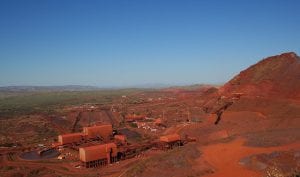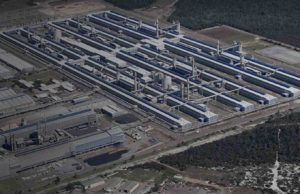Australia’s budget threatened Australian Renewable Energy Agency today joined Industry (and energy) minister Ian Macfarlane to celebrate one of the biggest successes of the federal government’s renewable grants program – Carnegie Wave Energy.
The head of ARENA, Ivor Frischnecht joined Macfarlane and WA energy minister Mike Nahan to mark the unveiling of the new CETO-5 units that will be used in Carnegie’s $33 million Perth wave energy project.
The project will be the first wave energy project in the world to feature the deployment of multiple machines, and the first to also deliver emissions-free desalinated water (to the Garden Island naval base).
ARENA has injected $13.1 million towards the project, and presumably did not miss the opportunity to remind Macfarlane of the importance of such funding.
There has been widespread speculation that ARENA, already stripped down to just $103 million in funds for the next three years, will be deprived of more funds in the upcoming May budget. ARENA was so concerned about the situation it released an extraordinary letter last week effectively warning project developers not to get too excited about their prospects.

Macfarlane’s presence at the unveiling is not surprising, given that he is a declared fan of wave energy and Carnegie in particular. At the Clean Energy Week conference in 2012, Macfarlane was positively glowing about the technology, even though he conceded it was unlikely to displace the incumbents for a decade or so. He was less effusive about wind and solar.
Carnegie is due to complete its Perth project this year, and will then embark on its most exciting yet, the CETO-6 project that will feature “commercial scale” machines that are four times bigger than the CETO-5s.
That project, which will likely lead to a facility of at least 30MW – will likely be built in Australia, thanks to support from the Clean Energy Finance Corporation, which offered it a $20 million loan facility if it keeps the project to Australian water.
Macfarlane, though, wants the CEFC to be scrapped. As he said in that 2012 speech, the CEFC is a fund that uses “taxpayers money to buy shares in green energy projects that the private sector will not support.”
That, though, is the nature of emerging technologies – and exactly what ARENA has done in the project that Macfarlane is now celebrating.
As he said in a statement today, the CETO wave energy technology is a world-leading home grown product that has been developed over 10 years by Carnegie, and such projects are long-term investments that are moving through the development phase.
“Australia has some of the best wave energy resources in the world with our south and south-west coast among the best in the world – it makes sense to tap into this renewable potential that will help diversify our energy mix, and that’s exactly what this project does,” Macfarlane said.
ARENA’s Frischknecht described the project as a “landmark demonstration” of a complete grid-connected, commercial scale CETO wave energy installation.
“Australia’s wave energy resources along our south and south-west coasts are among the best in the world and, importantly, can be reliably predicted days ahead. There is great long-term potential for wave energy in Australia, with a range of competitive Australian technologies being developed towards commercialisation.”
Frischknecht said the CETO-5 project will generate Carnegie’s first revenues and, although a relatively small generator, it was a significant step forward in commercialisation of the CETO wave energy technology.
“This is a prime example of how ARENA is supporting technologies through demonstration towards bankability to increase the competitiveness of renewable energy.”








